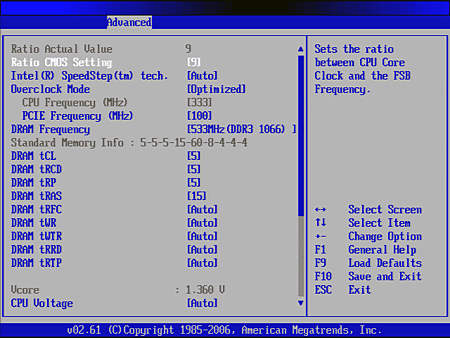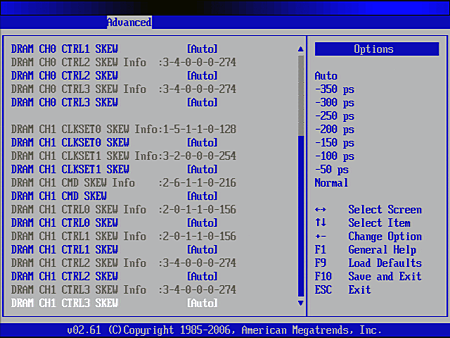11-Way P45 Motherboard Shootout
P45TS-R BIOS And Overclocking
| FSB Frequency | 100 to 800 MHz (1 MHz) |
| Clock Multiplier Adjustment | Yes |
| DRAM Ratios | 1.0, 1.2, 1.25, 1.5, 1.60, 1.67, 2.0 |
| PCIe Clock | 50 to 150MHz (1 MHz) |
| CPU Vcore | 0.81875 to 1.60 Volts (0.00625 Volts) |
| CPU FSB Voltage | Low, Middle, High, Highest |
| Northbridge (MCH) | Low, Middle, High, Highest |
| Southbridge (ICH) | Low, Middle, High, Highest |
| DDR2 Voltage | 1.79 - 2.72Volts (0.06 Volts) |
| DDR3 Voltage | 1.47 - 2.40Volts ( 0.06 Volts) |
| DDR2 Latency Settings | tCAS:3-7 ; tRCD : 3-10 ; tRP : 3-10 ; tRAS : 9-24 |
| DDR3 Latency Settings | tCAS:5-10 ; tRCD : 3-10 ; tRP : 3-10 ; tRAS : 9-24 |
The P45TS-R has all the BIOS settings we liked about the P45R2000-WiFi, along with the vague FSB, MCH, and ICH settings we didn’t. Once again, extreme overclockers won’t appreciate the 1.60V core limit, but this motherboard isn’t designed for the “at any cost” crowd.
The P45TS-R BIOS Overclocking menu has most of the features found in the CPU menu of ASRock’s other model, plus memory timings.
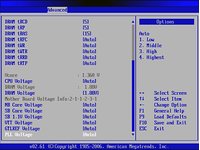
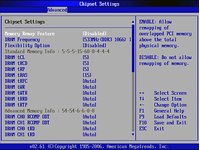
Scrolling down reveals voltage settings as well, which can be increased to enhance overclocking stability or decreased to reduce power and heat in an under-clocked system.
The Chipset menu looks like that of ASRock’s other entry, with memory speed and redundant timing settings.
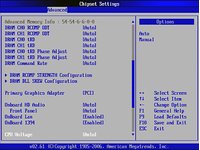
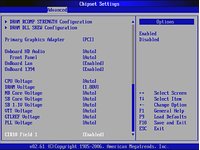
Further down the Chipset menu are onboard device controls.
At the bottom of the Chipset menu are voltage controls, which are again redundant to those found in the Overclocking menu.
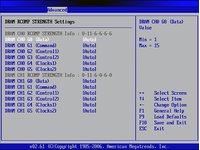
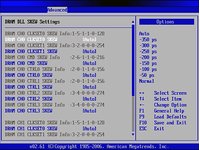
Do any end users actually adjust RCOMP Strength ? The settings were probably put here to bolster the motherboard’s overclocking aspirations.
Get Tom's Hardware's best news and in-depth reviews, straight to your inbox.
DRAM Skew controls are also probably just here for show, though anyone who really understands them might be able to get a slightly higher memory speed, or added performance, using these.
Current page: P45TS-R BIOS And Overclocking
Prev Page P45TS-R Onboard Devices Next Page P45TS-R Software And Accessories-
nickchalk Where are the lower price P45 M/B ?Reply
Asus P5Q pro is out for €110 and P5Q deluxe for €165 the price difference is about 70$ in Greece. -
Proximon I suppose I can get some good from having read this. Did you get paid by the word? Maybe next time you could just put together a complete features chart so that we can have some convenient comparison? You know, so someone could go to a chart and see at a glance which boards had eSATA or firewire, or 8 USB.Reply
-
JPForums I'd rather have the overabundance of information than a lack of information. Presentation could use a little refining (I.E. comparison charts and the likes), but having the relevant information available at least is a good thing.Reply -
the introduction and specifics are nice, the comparision isn't. so, why don't you test with an 8500 or qx9650? 6850 are outdated... and a mobo handling a c2d doesn't mean it can handle a quad too, see P5K for example (it stinks when it comes to a q6600).Reply
-
Crashman procithe introduction and specifics are nice, the comparision isn't. so, why don't you test with an 8500 or qx9650? 6850 are outdated... and a mobo handling a c2d doesn't mean it can handle a quad too, see P5K for example (it stinks when it comes to a q6600).Reply
Tom's Hardware wants the performance of current articles to reflect that of recent articles, so a "standard test platform" was chosen a while ago. It will get updated, but probably not before the new socket becomes widely available. -
zenmaster I would have liked to see something such as a P35 and an X48 as controls to help analyze the P45 Performance.Reply
In otherwords, What is the P45 Gaining me over the older P35.
What would I gain by going to the X48. (Or Lose) -
Crashman zenmasterI would have liked to see something such as a P35 and an X48 as controls to help analyze the P45 Performance.In otherwords, What is the P45 Gaining me over the older P35.What would I gain by going to the X48. (Or Lose)http://www.tomshardware.com/reviews/intel-p45-chipset,1961.htmlReply -
johnbilicki The first 17 pages were filled with nothing but junk from ASUS. Do us a favor: don't even bother featuring or *MENTIONING* anything for any reason from a company that refuses to RMA 200-400 dollar brand new motherboards with anything other then used and usually broken junk. It destroyed my enthusiasm for the article.Reply -
dobby nickchalkWhere are the lower price P45 M/B ?Asus P5Q pro is out for €110 and P5Q deluxe for €165 the price difference is about 70$ in Greece.Reply
the p5q PRo is a p43 board, i should know i have one
